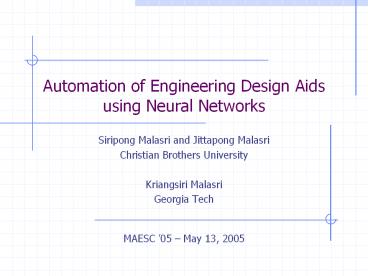Automation of Engineering Design Aids using Neural Networks - PowerPoint PPT Presentation
1 / 10
Title:
Automation of Engineering Design Aids using Neural Networks
Description:
Automation of Engineering Design Aids using Neural Networks Siripong Malasri and Jittapong Malasri Christian Brothers University Kriangsiri Malasri – PowerPoint PPT presentation
Number of Views:141
Avg rating:3.0/5.0
Title: Automation of Engineering Design Aids using Neural Networks
1
Automation of Engineering Design Aids using
Neural Networks
- Siripong Malasri and Jittapong Malasri
- Christian Brothers University
- Kriangsiri Malasri
- Georgia Tech
MAESC 05 May 13, 2005
2
Presentation Overview
- Introduction
- Artificial Neural Networks
- The Stress Concentration Problem
- Software Development
- Data preparation
- Network training and validation
- Standalone application development
- Conclusions and Future Work
3
Introduction
- Traditional design aids
- Look-up tables
- Graphical plots
- Shortcomings
- Inaccurate interpolation/extrapolation
- Difficult to smoothly integrate with computer
applications
4
Neural Networks
- Have been used to recognize patterns and project
trends in data - Backpropagation model can be trained to
generate desired input-output relationships
5
Stress Concentration (1)
- Objective
- Calculate the peak stress in a notched beam
cross-section subject to a bending moment - Possible approaches
- Finite-element analysis
- Experimental procedures
- Determine a stress concentration factor from a
design aid
6
Stress Concentration (2)
- Stress concentration factor, C
- Function of the ratios a/h2 and h1/h2
- Peak stress at notch
- M bending moment applied
- I cross-sectional moment of inertia
- c distance from N.A.
7
Software Data Preparation
- Training data obtained from a published graphical
design aid
- Inputs a/h2 , h1/h2
- Output C
- 46 training pairs, 15 calibration pairs, 15
validation pairs
8
Software Network Training
- NeuroShell 2 software
- Backpropagation network with 2 input neurons, 8
hidden neurons, and 1 output neuron - Excellent results from trained network
9
Software Standalone Program
- Interface developed in Visual Basic
- Network code generated from NeuroShell 2
10
Conclusions and Future Work
- Excellent network estimates of the stress
concentration factor for this particular
application - Standalone executable is portable to any Windows
computer - Future work comprehensive stress analysis
program with a variety of cross-sections































